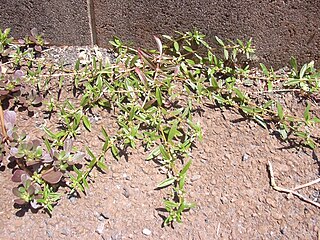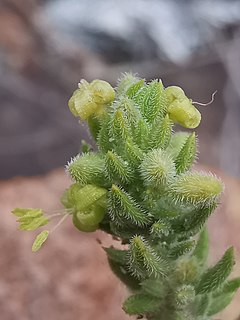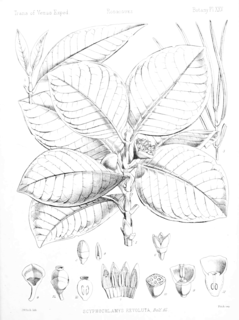
Oldenlandia is a genus of flowering plants in the family Rubiaceae. It is pantropical in distribution and has about 240 species. The type species for the genus is Oldenlandia corymbosa.

Anthospermum is a genus of flowering plants in the family Rubiaceae. It is found in Tropical and Southern Africa, Madagascar and in southwestern Arabian Peninsula.

Bertiera is a genus of flowering plants in the family Rubiaceae. It comprises 57 species with most known from tropical Africa, five known from various Indian Ocean islands and five found in the tropics of the Americas.

Kohautia is a genus of flowering plants in the family Rubiaceae. They are native to tropical areas of Asia, Africa, and Madagascar. Thirty-one species are known. The type species for the genus is Kohautia senegalensis.

Polysphaeria is a genus of plant in the family Rubiaceae, and its native range is Madagascar and Tropical Africa. It contains the following 22 species according to Plants of the World Online:

Pyrostria is a genus of dioecious flowering plants in the family Rubiaceae. Most of the species are endemic to Madagascar, others occur on islands in the western Indian Ocean, a few are found in continental Africa, and only six species occur in tropical Southeast Asia. The formerly recognized genus Leroya, containing two species endemic to Madagascar, L. madagascariensis and L. richardiae, was sunk into synonymy with Pyrostria.
Rytigynia is a genus of flowering plants in the family Rubiaceae. It is found in tropical and southern Africa. The genera Rytigynia and Fadogia form a strongly supported clade but neither of these genera is monophyletic.

Fadogia is a genus of flowering plants in the family Rubiaceae. The genera Rytigynia and Fadogia form a strongly supported clade but neither of these genera is monophyletic.
Peponidium is a genus of flowering plants in the family Rubiaceae. The genus is endemic to Madagascar, except for Peponidium ovato-oblongum and Peponidium venulosum that are found on the Comoros, and Peponidium carinatum and Peponidium celastroides that are found on the Seychelles.

Pentanisia is a genus of flowering plants in the family Rubiaceae.
Craterispermum is a genus of flowering plants in the family Rubiaceae. It contains 16 species that occur in tropical Africa and Seychelles. It is the only genus in the tribe Craterispermeae, of which the divergence time is estimated at 34.8 million years ago.
Chamaepentas is a genus of flowering plants in the family Rubiaceae. It is native to tropical Africa.
Chassalia is a genus of flowering plants in the family Rubiaceae. The genus is found from tropical Africa to (sub)tropical Asia.
Dolichopentas is a genus of flowering plants in the family Rubiaceae. The genus is found in tropical Africa.
Knoxieae is a tribe of flowering plants in the family Rubiaceae and contains about 131 species in 16 genera. Its representatives are found in Tropical and Southern Africa, the islands in the Western Indian Ocean, the Arabian Peninsula, Tropical and Subtropical Asia, and Northern Australia.
Walter Carl Otto Busse was a German botanist, whose primary scholarly focus was on German agriculture and the plants, fungi and lichen of Africa.
Rhodopentas is a genus of flowering plants belonging to the family Rubiaceae.







